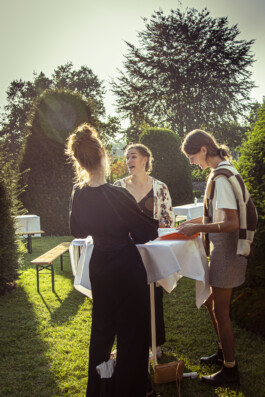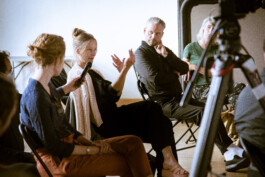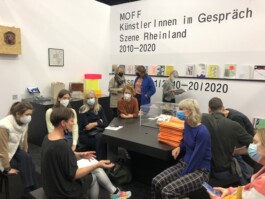Digital Finissage Review



After three eventful months of field trips, workshops, art market insights and many glasses of wine at many dinner tables, the Borderland Residencies 2021 come to an end. But while this is a “thank you” letter to everyone who helped make this programme as special as it has been, it is not a “goodbye” – think of it more as a “see you soon”.
On November 30th, the Borderland Residencies 2021 concluded in a digital finissage. It looked back on the individual journeys of each artist during their residency. As everyone shared their experiences, it became a diverting 1,5 hours that passed in next to no time.
The event started off with welcoming words of Dr. Ingrid Misterek-Plagge, Kulturraum Niederrhein e.V., and Peter Schuurman, Consul General of the Kingdom of the Netherlands, but quickly cleared the stage for the special guests: the scholarship holders of the Borderland Reisdencies. Since most scholarship holders attended the digital event right from their studios, the audience was given live-insights into their works and works in progress.
At the core of a residency
Sanne Vaassen, resident at Atelierhaus Neuss and Isabell Schulte, scholarship holder of Kunstgenerator Viersen, both put emphasis on how a residency influences the works they create. Sanne said: “What I had planned for my stay in Neuss did not happen; something new evolved instead and will be continued in the future. A residency is something you take home.” Isabell underlined how much the calm and quiet environment of Viersen is distinct from her studio in Berlin. The changed daily routine helped her focus more intensely on her drawing up until the point where she started “living in the drawing”: “In Viersen, the excitement did not come from the city, but from within the drawing itself.” She also admitted that at times, the seclusion of a residency could make an artist feel lonely in the foreign environment. “But this is when the Borderlands programme happened,” she said, “it filled the gap of what the residency was missing: it allowed me to meet other artists, places and people.” Judith Reijnders, a young artist from Maastricht who just started her career, could relate to what Sanne and Isabell described: “It was great to see the other residencies. It helps you understand what residencies are and what artists can expect of them. For me, Borderland Residencies also was a good re-start after the lockdown.”
The challenge of participative art
At Ringenberg Castle, the collective Observatory Working Group gave their residency the title “landing point” but soon realised that it was not a landing, but a starting point for their future collective works. Their participatory approach, which aimed to involve the inhabitants of Hamminkeln-Ringenberg, made them realise that in order to include people into their projects, “one of the first borders that you need to tear down is the border of the castle you’re staying at.” Ringenberg Castle has a long history of being a place for artists in residence and is currently in the process of relaunching their portfolio towards more participative programmes. MOFF collective, who also stayed at Ringenberg Castle during the Borderland Residenices, took that thought and formed it into action: On November 13th, they declared the Republic of Ringenberg – a place for encounter and a kingdom of the arts.
Artistic self-concepts in the Netherlands and Germany
The self-concept of the artist as a person who does not separate from society but actively engages with the public might not generally be recognized in Germany, but it definitely already is the matter of course in the Netherlands. The residency programme “Nieuwe Uitzichten”, a cooperation between Museum van Bommel van Dam in Venlo and Odapark, center for contemporary art in Venray, does not shy away from addressing the bid topics of our generation through their AIR programme: In eight towns and cities throughout the province of Limburg, they invited artists and designers into projects of sustainable city planning. This way, artists engage with the practical intricacy of inner-city and industrial landscapes that try to reshape into greener environments. Mona Steinhäußer and Fabian Seibert, both German artists who were temporarily based in the Netherlands for studies and projects, support the Dutch approach of art that is accessible to everyone. “In Germany, artists don’t want to be functionalized or consumed by the viewer. There still is a clear separation between making art and making money. In the Netherlands, there is an apparent shift: Here, your art needs to be accessible to people if you want to get any funding at all.” Mona finds the Dutch procedure to be more challenging concerning her own work. “What is my position as a designer or an artist?” she askes and explores: “It is intense on your own artistic work to include big topics like sustainability.”
Harfsen based artist Lobke Meekes is used to that Dutch approach: She has always worked in participatory art projects throughout her entire carrier and has a lot of experience working, for example, with school classes. But still, she could relate to the observations of the other scholarship holders and described the impact the meetings with gallery owners at Art Cologne had on her: “Seeing all the “sell-able art-art” in the galleries really made me actively reflect where and who I want to be as an artist.”

Emy Bensdorp, a young designer from Amsterdam, focuses on sustainable material development, especially the transformation of polluted soil into clean ceramics. Emy said how she enjoyed to be part of a programme in which both designers and artists could participate: “Just like there are specific characteristics of the art markets in Germany and the Netherlands, there are similarities and differences between art and design as well. But there is no valuation there – I don’t want to label it.”
Maybe the promising name of the Dutch AIR programme – Nieuwe Uitzichten translates into New Prospects – is all the label it needs: it challenges every participant to step out of their personal comfort zones and to confront themselves with new work procedures. German artist Christian Odzuck also leaves behind the well-known contexts of his previous projects and dives deep into the recycling of materials that have been used in an industrial context before. Thereby, landscapes change and reshape as well as materials. “Visiting all those different landscapes during the Borderlands programme gave me a lot of inspiration for my residency project,” Christian explained.
The last scholarship holder to present his art that day was Viron Erol Vert, future resident of Internationales Atelierstipendium Mönchengladbach, who joined Borderland Residencies “the other way around”: Viron, currently still an artist in residence at Urbane Künste Ruhr, will start his residency in spring 2022. He expressed his gratitude for being able to explore the region beforehand: “During my residency, I want to discover the different relationships between rural and urban landscapes on both sides of the border. Borderland Residencies has given me a useful preview.”
Outlook
If Borderland Residencies has shown one thing, it is that there indeed is no need to label the very different people, programmes and residencies. There is one label that everyone will willingly accept, though: That bringing together the unexpected always creates something greater! And 2021 was only the first round of Borderland Residencies. The programme will be back in 2022 with new artists, designers, residency partners and an alumni-programme for the 2021 participants.

See you soon in the Borderlands – let’s continue to work together!
Digital Finissage Review



After three eventful months of field trips, workshops, art market insights and many glasses of wine at many dinner tables, the Borderland Residencies 2021 come to an end. But while this is a “thank you” letter to everyone who helped make this programme as special as it has been, it is not a “goodbye” – think of it more as a “see you soon”.
On November 30th, the Borderland Residencies 2021 concluded in a digital finissage. It looked back on the individual journeys of each artist during their residency. As everyone shared their experiences, it became a diverting 1,5 hours that passed in next to no time.
The event started off with welcoming words of Dr. Ingrid Misterek-Plagge, Kulturraum Niederrhein e.V., and Peter Schuurman, Consul General of the Kingdom of the Netherlands, but quickly cleared the stage for the special guests: the scholarship holders of the Borderland Reisdencies. Since most scholarship holders attended the digital event right from their studios, the audience was given live-insights into their works and works in progress.
At the core of a residency
Sanne Vaassen, resident at Atelierhaus Neuss and Isabell Schulte, scholarship holder of Kunstgenerator Viersen, both put emphasis on how a residency influences the works they create. Sanne said: “What I had planned for my stay in Neuss did not happen; something new evolved instead and will be continued in the future. A residency is something you take home.” Isabell underlined how much the calm and quiet environment of Viersen is distinct from her studio in Berlin. The changed daily routine helped her focus more intensely on her drawing up until the point where she started “living in the drawing”: “In Viersen, the excitement did not come from the city, but from within the drawing itself.” She also admitted that at times, the seclusion of a residency could make an artist feel lonely in the foreign environment. “But this is when the Borderlands programme happened,” she said, “it filled the gap of what the residency was missing: it allowed me to meet other artists, places and people.” Judith Reijnders, a young artist from Maastricht who just started her career, could relate to what Sanne and Isabell described: “It was great to see the other residencies. It helps you understand what residencies are and what artists can expect of them. For me, Borderland Residencies also was a good re-start after the lockdown.”
The challenge of participative art
At Ringenberg Castle, the collective Observatory Working Group gave their residency the title “landing point” but soon realised that it was not a landing, but a starting point for their future collective works. Their participatory approach, which aimed to involve the inhabitants of Hamminkeln-Ringenberg, made them realise that in order to include people into their projects, “one of the first borders that you need to tear down is the border of the castle you’re staying at.” Ringenberg Castle has a long history of being a place for artists in residence and is currently in the process of relaunching their portfolio towards more participative programmes. MOFF collective, who also stayed at Ringenberg Castle during the Borderland Residenices, took that thought and formed it into action: On November 13th, they declared the Republic of Ringenberg – a place for encounter and a kingdom of the arts.
Artistic self-concepts in the Netherlands and Germany
The self-concept of the artist as a person who does not separate from society but actively engages with the public might not generally be recognized in Germany, but it definitely already is the matter of course in the Netherlands. The residency programme “Nieuwe Uitzichten”, a cooperation between Museum van Bommel van Dam in Venlo and Odapark, center for contemporary art in Venray, does not shy away from addressing the bid topics of our generation through their AIR programme: In eight towns and cities throughout the province of Limburg, they invited artists and designers into projects of sustainable city planning. This way, artists engage with the practical intricacy of inner-city and industrial landscapes that try to reshape into greener environments. Mona Steinhäußer and Fabian Seibert, both German artists who were temporarily based in the Netherlands for studies and projects, support the Dutch approach of art that is accessible to everyone. “In Germany, artists don’t want to be functionalized or consumed by the viewer. There still is a clear separation between making art and making money. In the Netherlands, there is an apparent shift: Here, your art needs to be accessible to people if you want to get any funding at all.” Mona finds the Dutch procedure to be more challenging concerning her own work. “What is my position as a designer or an artist?” she askes and explores: “It is intense on your own artistic work to include big topics like sustainability.”
Harfsen based artist Lobke Meekes is used to that Dutch approach: She has always worked in participatory art projects throughout her entire carrier and has a lot of experience working, for example, with school classes. But still, she could relate to the observations of the other scholarship holders and described the impact the meetings with gallery owners at Art Cologne had on her: “Seeing all the “sell-able art-art” in the galleries really made me actively reflect where and who I want to be as an artist.”

Emy Bensdorp, a young designer from Amsterdam, focuses on sustainable material development, especially the transformation of polluted soil into clean ceramics. Emy said how she enjoyed to be part of a programme in which both designers and artists could participate: “Just like there are specific characteristics of the art markets in Germany and the Netherlands, there are similarities and differences between art and design as well. But there is no valuation there – I don’t want to label it.”
Maybe the promising name of the Dutch AIR programme – Nieuwe Uitzichten translates into New Prospects – is all the label it needs: it challenges every participant to step out of their personal comfort zones and to confront themselves with new work procedures. German artist Christian Odzuck also leaves behind the well-known contexts of his previous projects and dives deep into the recycling of materials that have been used in an industrial context before. Thereby, landscapes change and reshape as well as materials. “Visiting all those different landscapes during the Borderlands programme gave me a lot of inspiration for my residency project,” Christian explained.
The last scholarship holder to present his art that day was Viron Erol Vert, future resident of Internationales Atelierstipendium Mönchengladbach, who joined Borderland Residencies “the other way around”: Viron, currently still an artist in residence at Urbane Künste Ruhr, will start his residency in spring 2022. He expressed his gratitude for being able to explore the region beforehand: “During my residency, I want to discover the different relationships between rural and urban landscapes on both sides of the border. Borderland Residencies has given me a useful preview.”
Outlook
If Borderland Residencies has shown one thing, it is that there indeed is no need to label the very different people, programmes and residencies. There is one label that everyone will willingly accept, though: That bringing together the unexpected always creates something greater! And 2021 was only the first round of Borderland Residencies. The programme will be back in 2022 with new artists, designers, residency partners and an alumni-programme for the 2021 participants.

See you soon in the Borderlands – let’s continue to work together!